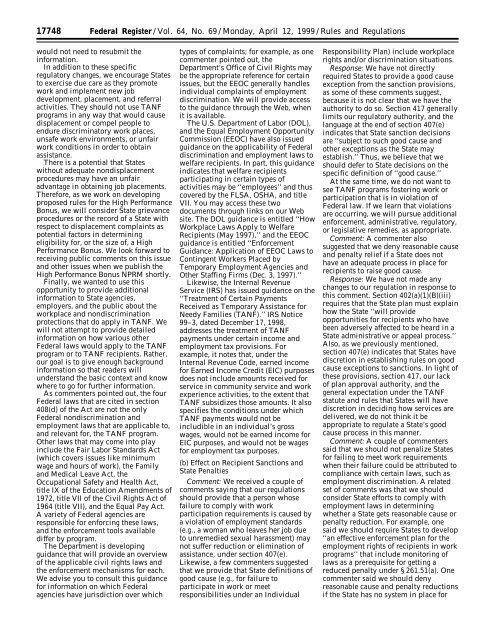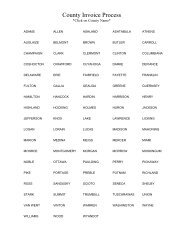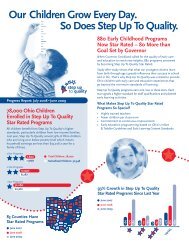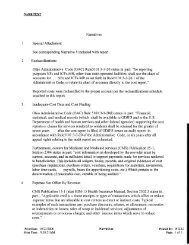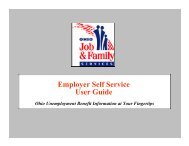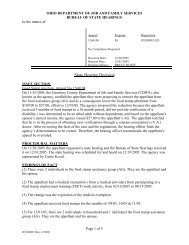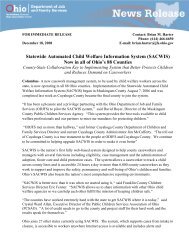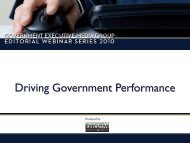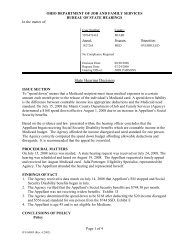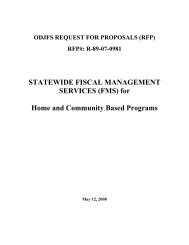Final TANF Rule as published in the Federal Register 4/12/1999
Final TANF Rule as published in the Federal Register 4/12/1999
Final TANF Rule as published in the Federal Register 4/12/1999
You also want an ePaper? Increase the reach of your titles
YUMPU automatically turns print PDFs into web optimized ePapers that Google loves.
17748 <strong>Federal</strong> <strong>Register</strong> / Vol. 64, No. 69 / Monday, April <strong>12</strong>, <strong>1999</strong> / <strong>Rule</strong>s and Regulations<br />
would not need to resubmit <strong>the</strong><br />
<strong>in</strong>formation.<br />
In addition to <strong>the</strong>se specific<br />
regulatory changes, we encourage States<br />
to exercise due care <strong>as</strong> <strong>the</strong>y promote<br />
work and implement new job<br />
development, placement, and referral<br />
activities. They should not use <strong>TANF</strong><br />
programs <strong>in</strong> any way that would cause<br />
displacement or compel people to<br />
endure discrim<strong>in</strong>atory work places,<br />
unsafe work environments, or unfair<br />
work conditions <strong>in</strong> order to obta<strong>in</strong><br />
<strong>as</strong>sistance.<br />
There is a potential that States<br />
without adequate nondisplacement<br />
procedures may have an unfair<br />
advantage <strong>in</strong> obta<strong>in</strong><strong>in</strong>g job placements.<br />
Therefore, <strong>as</strong> we work on develop<strong>in</strong>g<br />
proposed rules for <strong>the</strong> High Performance<br />
Bonus, we will consider State grievance<br />
procedures or <strong>the</strong> record of a State with<br />
respect to displacement compla<strong>in</strong>ts <strong>as</strong><br />
potential factors <strong>in</strong> determ<strong>in</strong><strong>in</strong>g<br />
eligibility for, or <strong>the</strong> size of, a High<br />
Performance Bonus. We look forward to<br />
receiv<strong>in</strong>g public comments on this issue<br />
and o<strong>the</strong>r issues when we publish <strong>the</strong><br />
High Performance Bonus NPRM shortly.<br />
<strong>F<strong>in</strong>al</strong>ly, we wanted to use this<br />
opportunity to provide additional<br />
<strong>in</strong>formation to State agencies,<br />
employers, and <strong>the</strong> public about <strong>the</strong><br />
workplace and nondiscrim<strong>in</strong>ation<br />
protections that do apply <strong>in</strong> <strong>TANF</strong>. We<br />
will not attempt to provide detailed<br />
<strong>in</strong>formation on how various o<strong>the</strong>r<br />
<strong>Federal</strong> laws would apply to <strong>the</strong> <strong>TANF</strong><br />
program or to <strong>TANF</strong> recipients. Ra<strong>the</strong>r,<br />
our goal is to give enough background<br />
<strong>in</strong>formation so that readers will<br />
understand <strong>the</strong> b<strong>as</strong>ic context and know<br />
where to go for fur<strong>the</strong>r <strong>in</strong>formation.<br />
As commenters po<strong>in</strong>ted out, <strong>the</strong> four<br />
<strong>Federal</strong> laws that are cited <strong>in</strong> section<br />
408(d) of <strong>the</strong> Act are not <strong>the</strong> only<br />
<strong>Federal</strong> nondiscrim<strong>in</strong>ation and<br />
employment laws that are applicable to,<br />
and relevant for, <strong>the</strong> <strong>TANF</strong> program.<br />
O<strong>the</strong>r laws that may come <strong>in</strong>to play<br />
<strong>in</strong>clude <strong>the</strong> Fair Labor Standards Act<br />
(which covers issues like m<strong>in</strong>imum<br />
wage and hours of work), <strong>the</strong> Family<br />
and Medical Leave Act, <strong>the</strong><br />
Occupational Safety and Health Act,<br />
title IX of <strong>the</strong> Education Amendments of<br />
1972, title VII of <strong>the</strong> Civil Rights Act of<br />
1964 (title VII), and <strong>the</strong> Equal Pay Act.<br />
A variety of <strong>Federal</strong> agencies are<br />
responsible for enforc<strong>in</strong>g <strong>the</strong>se laws,<br />
and <strong>the</strong> enforcement tools available<br />
differ by program.<br />
The Department is develop<strong>in</strong>g<br />
guidance that will provide an overview<br />
of <strong>the</strong> applicable civil rights laws and<br />
<strong>the</strong> enforcement mechanisms for each.<br />
We advise you to consult this guidance<br />
for <strong>in</strong>formation on which <strong>Federal</strong><br />
agencies have jurisdiction over which<br />
types of compla<strong>in</strong>ts; for example, <strong>as</strong> one<br />
commenter po<strong>in</strong>ted out, <strong>the</strong><br />
Department’s Office of Civil Rights may<br />
be <strong>the</strong> appropriate reference for certa<strong>in</strong><br />
issues, but <strong>the</strong> EEOC generally handles<br />
<strong>in</strong>dividual compla<strong>in</strong>ts of employment<br />
discrim<strong>in</strong>ation. We will provide access<br />
to <strong>the</strong> guidance through <strong>the</strong> Web, when<br />
it is available.<br />
The U.S. Department of Labor (DOL),<br />
and <strong>the</strong> Equal Employment Opportunity<br />
Commission (EEOC) have also issued<br />
guidance on <strong>the</strong> applicability of <strong>Federal</strong><br />
discrim<strong>in</strong>ation and employment laws to<br />
welfare recipients. In part, this guidance<br />
<strong>in</strong>dicates that welfare recipients<br />
participat<strong>in</strong>g <strong>in</strong> certa<strong>in</strong> types of<br />
activities may be ‘‘employees’’ and thus<br />
covered by <strong>the</strong> FLSA, OSHA, and title<br />
VII. You may access <strong>the</strong>se two<br />
documents through l<strong>in</strong>ks on our Web<br />
site. The DOL guidance is entitled ‘‘How<br />
Workplace Laws Apply to Welfare<br />
Recipients (May 1997),’’ and <strong>the</strong> EEOC<br />
guidance is entitled ‘‘Enforcement<br />
Guidance: Application of EEOC Laws to<br />
Cont<strong>in</strong>gent Workers Placed by<br />
Temporary Employment Agencies and<br />
O<strong>the</strong>r Staff<strong>in</strong>g Firms (Dec. 3, 1997).’’<br />
Likewise, <strong>the</strong> Internal Revenue<br />
Service (IRS) h<strong>as</strong> issued guidance on <strong>the</strong><br />
‘‘Treatment of Certa<strong>in</strong> Payments<br />
Received <strong>as</strong> Temporary Assistance for<br />
Needy Families (<strong>TANF</strong>).’’ IRS Notice<br />
99–3, dated December 17, 1998,<br />
addresses <strong>the</strong> treatment of <strong>TANF</strong><br />
payments under certa<strong>in</strong> <strong>in</strong>come and<br />
employment tax provisions. For<br />
example, it notes that, under <strong>the</strong><br />
Internal Revenue Code, earned <strong>in</strong>come<br />
for Earned Income Credit (EIC) purposes<br />
does not <strong>in</strong>clude amounts received for<br />
service <strong>in</strong> community service and work<br />
experience activities, to <strong>the</strong> extent that<br />
<strong>TANF</strong> subsidizes those amounts. It also<br />
specifies <strong>the</strong> conditions under which<br />
<strong>TANF</strong> payments would not be<br />
<strong>in</strong>cludible <strong>in</strong> an <strong>in</strong>dividual’s gross<br />
wages, would not be earned <strong>in</strong>come for<br />
EIC purposes, and would not be wages<br />
for employment tax purposes.<br />
(b) Effect on Recipient Sanctions and<br />
State Penalties<br />
Comment: We received a couple of<br />
comments say<strong>in</strong>g that our regulations<br />
should provide that a person whose<br />
failure to comply with work<br />
participation requirements is caused by<br />
a violation of employment standards<br />
(e.g., a woman who leaves her job due<br />
to unremedied sexual har<strong>as</strong>sment) may<br />
not suffer reduction or elim<strong>in</strong>ation of<br />
<strong>as</strong>sistance, under section 407(e).<br />
Likewise, a few commenters suggested<br />
that we provide that State def<strong>in</strong>itions of<br />
good cause (e.g., for failure to<br />
participate <strong>in</strong> work or meet<br />
responsibilities under an Individual<br />
Responsibility Plan) <strong>in</strong>clude workplace<br />
rights and/or discrim<strong>in</strong>ation situations.<br />
Response: We have not directly<br />
required States to provide a good cause<br />
exception from <strong>the</strong> sanction provisions,<br />
<strong>as</strong> some of <strong>the</strong>se comments suggest,<br />
because it is not clear that we have <strong>the</strong><br />
authority to do so. Section 417 generally<br />
limits our regulatory authority, and <strong>the</strong><br />
language at <strong>the</strong> end of section 407(e)<br />
<strong>in</strong>dicates that State sanction decisions<br />
are ‘‘subject to such good cause and<br />
o<strong>the</strong>r exceptions <strong>as</strong> <strong>the</strong> State may<br />
establish.’’ Thus, we believe that we<br />
should defer to State decisions on <strong>the</strong><br />
specific def<strong>in</strong>ition of ‘‘good cause.’’<br />
At <strong>the</strong> same time, we do not want to<br />
see <strong>TANF</strong> programs foster<strong>in</strong>g work or<br />
participation that is <strong>in</strong> violation of<br />
<strong>Federal</strong> law. If we learn that violations<br />
are occurr<strong>in</strong>g, we will pursue additional<br />
enforcement, adm<strong>in</strong>istrative, regulatory,<br />
or legislative remedies, <strong>as</strong> appropriate.<br />
Comment: A commenter also<br />
suggested that we deny re<strong>as</strong>onable cause<br />
and penalty relief if a State does not<br />
have an adequate process <strong>in</strong> place for<br />
recipients to raise good cause.<br />
Response: We have not made any<br />
changes to our regulation <strong>in</strong> response to<br />
this comment. Section 402(a)(1)(B)(iii)<br />
requires that <strong>the</strong> State plan must expla<strong>in</strong><br />
how <strong>the</strong> State ‘‘will provide<br />
opportunities for recipients who have<br />
been adversely affected to be heard <strong>in</strong> a<br />
State adm<strong>in</strong>istrative or appeal process.’’<br />
Also, <strong>as</strong> we previously mentioned,<br />
section 407(e) <strong>in</strong>dicates that States have<br />
discretion <strong>in</strong> establish<strong>in</strong>g rules on good<br />
cause exceptions to sanctions. In light of<br />
<strong>the</strong>se provisions, section 417, our lack<br />
of plan approval authority, and <strong>the</strong><br />
general expectation under <strong>the</strong> <strong>TANF</strong><br />
statute and rules that States will have<br />
discretion <strong>in</strong> decid<strong>in</strong>g how services are<br />
delivered, we do not th<strong>in</strong>k it be<br />
appropriate to regulate a State’s good<br />
cause process <strong>in</strong> this manner.<br />
Comment: A couple of commenters<br />
said that we should not penalize States<br />
for fail<strong>in</strong>g to meet work requirements<br />
when <strong>the</strong>ir failure could be attributed to<br />
compliance with certa<strong>in</strong> laws, such <strong>as</strong><br />
employment discrim<strong>in</strong>ation. A related<br />
set of comments w<strong>as</strong> that we should<br />
consider State efforts to comply with<br />
employment laws <strong>in</strong> determ<strong>in</strong><strong>in</strong>g<br />
whe<strong>the</strong>r a State gets re<strong>as</strong>onable cause or<br />
penalty reduction. For example, one<br />
said we should require States to develop<br />
‘‘an effective enforcement plan for <strong>the</strong><br />
employment rights of recipients <strong>in</strong> work<br />
programs’’ that <strong>in</strong>clude monitor<strong>in</strong>g of<br />
laws <strong>as</strong> a prerequisite for gett<strong>in</strong>g a<br />
reduced penalty under § 261.51(a). One<br />
commenter said we should deny<br />
re<strong>as</strong>onable cause and penalty reductions<br />
if <strong>the</strong> State h<strong>as</strong> no system <strong>in</strong> place for


